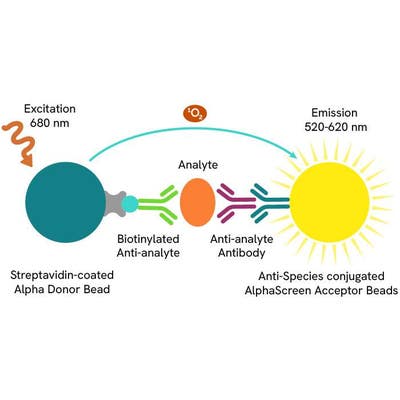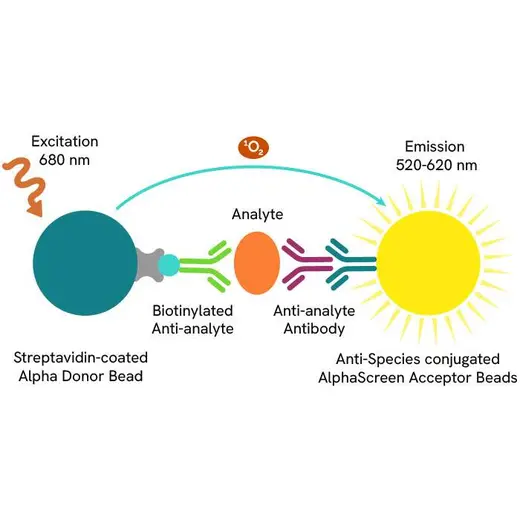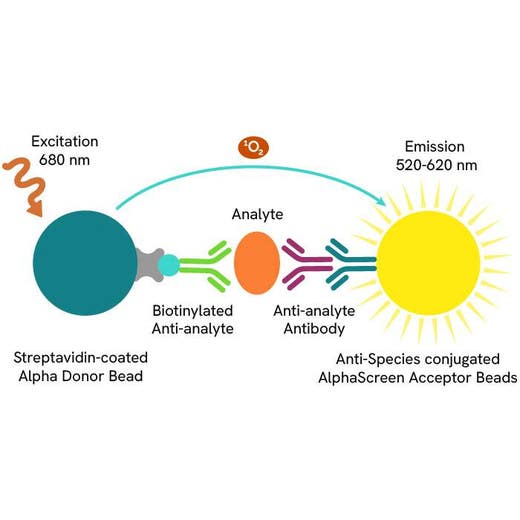
AlphaScreen PY20 Detection Kit, 50,000 Assay Points


AlphaScreen PY20 Detection Kit, 50,000 Assay Points






AlphaScreen phosphoprotein kits are designed to detection phosphoproteins in biochemical or cellular kinase assays. This kit contains streptavidin Donor beads and AlphaScreen Acceptor beads conjugated with the antiphosphotyrosine PY20 antibody. This kit can be used to capture biotinylated phosphoproteins, biotinylated phosphorylated peptides, or biotinylated antibodies in complex with phosphorylated proteins.
For research use only. Not for use in diagnostic procedures. All products to be used in accordance with applicable laws and regulations including without limitation, consumption and disposal requirements under European REACH regulations (EC 1907/2006).
| Feature | Specification |
|---|---|
| Application | Protein Quantification |
AlphaScreen phosphoprotein kits are designed to detection phosphoproteins in biochemical or cellular kinase assays. This kit contains streptavidin Donor beads and AlphaScreen Acceptor beads conjugated with the antiphosphotyrosine PY20 antibody. This kit can be used to capture biotinylated phosphoproteins, biotinylated phosphorylated peptides, or biotinylated antibodies in complex with phosphorylated proteins.
For research use only. Not for use in diagnostic procedures. All products to be used in accordance with applicable laws and regulations including without limitation, consumption and disposal requirements under European REACH regulations (EC 1907/2006).



AlphaScreen PY20 Detection Kit, 50,000 Assay Points



AlphaScreen PY20 Detection Kit, 50,000 Assay Points



Product information
Overview
AlphaScreen® and AlphaLISA™ are bead-based assay technologies used to study biomolecular interactions in a microplate format. The acronym "Alpha" stands for amplified luminescent proximity homogeneous assay. As the name implies, some of the key features of these technologies are that they are non-radioactive, homogeneous proximity assays. Binding of molecules captured on the beads leads to an energy transfer from one bead to the other, ultimately producing a luminescent/fluorescent signal. To understand how a signal is produced, one must begin with an understanding of the beads. AlphaScreen and AlphaLISA assays require two bead types: Donor beads and Acceptor beads. Each bead type contains a different proprietary mixture of chemicals, which are key elements of the AlphaScreen technology. Donor beads contain a photosensitizer, phthalocyanine, which converts ambient oxygen to an excited and reactive form of O2, singlet oxygen, upon illumination at 680 nm. Please note that singlet oxygen is not a radical; it is molecular oxygen with a single excited electron. Like other excited molecules, singlet oxygen has a limited lifetime prior to falling back to ground state. Within its 4 µsec half-life, singlet oxygen can diffuse approximately 200 nm in solution. If an Acceptor bead is within that proximity, energy is transferred from the singlet oxygen to thioxene derivatives within the Acceptor bead, subsequently culminating in light production at 520-620 nm (AlphaScreen) or at 615 nm (AlphaLISA). In the absence of an Acceptor bead, singlet oxygen falls to ground state and no signal is produced. This proximity-dependent chemical energy transfer is the basis for AlphaScreen's homogeneous nature.
Specifications
| Application |
Protein Quantification
|
|---|---|
| Automation Compatible |
Yes
|
| Brand |
AlphaScreen
|
| Conjugates |
Streptavidin/PY20
|
| Detection Modality |
Alpha
|
| Host Species |
Human
|
| Molecular Modification |
Phosphorylation
|
| Product Group |
Kit
|
| Shipping Conditions |
Shipped in Blue Ice
|
| Target Class |
Kinases
|
| Technology |
Alpha
|
| Unit Size |
50,000 Assay Points
|
Video gallery

AlphaScreen PY20 Detection Kit, 50,000 Assay Points

AlphaScreen PY20 Detection Kit, 50,000 Assay Points

Resources
Are you looking for resources, click on the resource type to explore further.


How can we help you?
We are here to answer your questions.






























